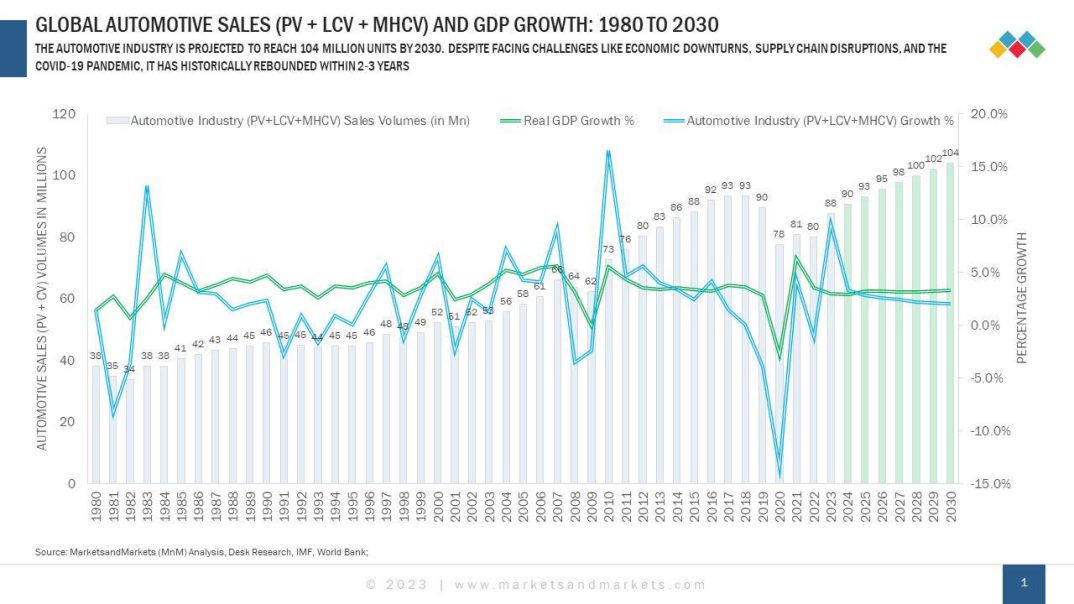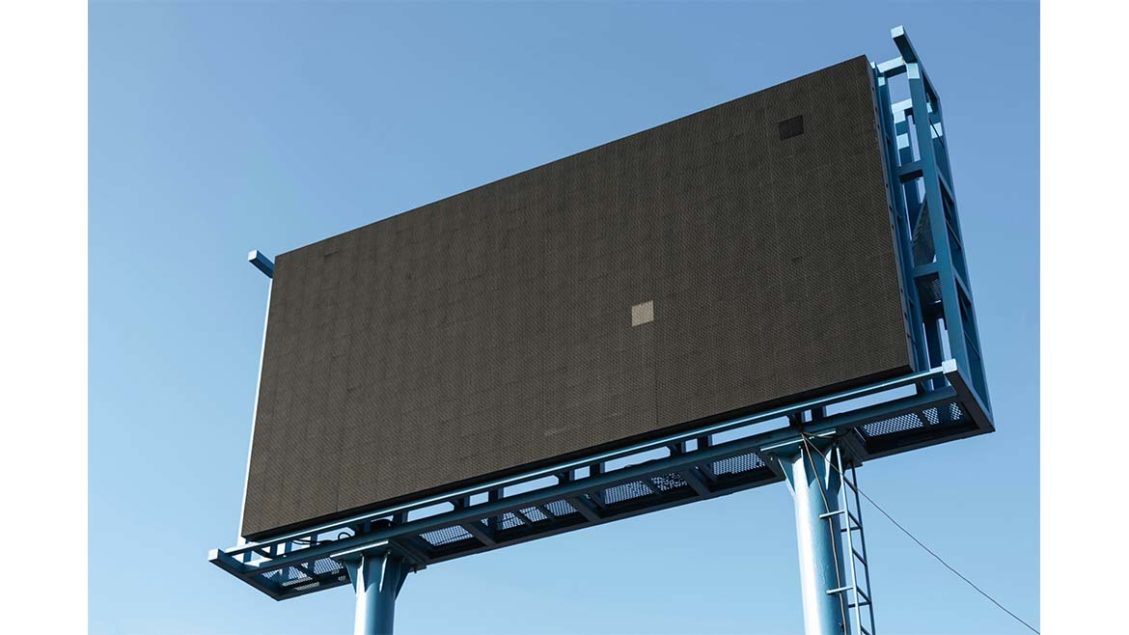Remember that time you were stuck in bumper-to-bumper traffic, inching forward with a sinking feeling in your stomach, wishing for a magical solution? The automotive industry is in a similar position, stuck in a traffic jam but on the cusp of a revolution, and that magical solution might not be as far-fetched as you think.
Having spent 30 years in the industry, I’ve witnessed firsthand the constant churn of innovation that drives this industry and gives us drivers amazing new features. However, the car has remained what it is—metal on four wheels with seats for the last 100 years. But lately, the pace of change feels like it’s ready to go into overdrive. This transformation is driven by a confluence of factors like environmental concerns, evolving consumer preferences, digital and technological advancements, geopolitics, and a global economic landscape in flux.
Let’s take a look at what my foresighting team at MarketsandMarkets has forecasted for the future of the automotive industry in their recently published report.
A Resilient Industry
The automotive industry has a remarkable history of resilience, consistently rebounding from economic downturns. This resilience is poised to continue, with the industry expected to thrive and innovate well into 2035. Historically, the industry has shown a strong correlation with Real GDP growth, particularly light vehicle sales, indicating a robust connection to economic health. The typical recovery pattern, often a V or U curve, suggests that the automotive sector bounces back within 2 years of a recession, positioning itself for sustained growth. With car average age at an all-time record high and touching teens, replacement cycles are expected to kick off in the developed world.
Global Auto Sales 1980 – 2030
Markets and Markets
The milestones of 100 million sales by 2028 and a global vehicle parc of 2 billion by 2030 are just the beginning of this transformative journey.
Peak ICE: EVs Take the Lead, But Not Without a Bump
While electric vehicles (EVs) may face a temporary growth rate slowdown, they are projected to surpass internal combustion engine (ICE) vehicles by 2036, the same year we will see Peak ICE. This shift will mark a significant turning point in the automotive industry, driven by advancements in battery technology, including the shift to new chemistries like solid-state batteries, reducing battery prices below $80 per kWh, and increasing battery life cycles. Additionally, growing environmental awareness will further propel this transformation.
They say the future belongs to those who can innovate and adapt. This is where we see Chinese manufacturers like BYD, Geely, Chery, Changan, and SAIC taking center stage. Their strong EV portfolios position them to be key players in the coming years.
Emerging Markets: A New Wave of Demand
India’s automotive industry is experiencing a surge in growth, contributing significantly to the global market. Although it may not surpass China in sales, India’s robust growth rate is driving substantial manufacturing development. Emerging markets such as India and Indonesia are poised to be key contributors between 2025 and 2030. From 2030 to 2035, Mexico, the Philippines, and Turkey will join the list of significant growth drivers. Post-2035, Nigeria is expected to lead the growth trajectory.
This growth will be further fueled by a rising middle class and Gen Z population. As a technology oriented consumer myself, I could relate to the Gen Z population’s inclination towards innovative, tech-savvy, and eco-friendly automotive solutions, and we will see new vehicle model designs and connectivity features attract this new customer base. The implications of this demographic shift will certainly redefine the industry’s approach to product development and marketing strategies.
Consolidation of EV Platforms
The next seven years will witness a significant consolidation of EV platforms. OEMs are set to reduce the number of platforms by more than 60%. EV rolling chassis can constitute 70-85% of total BEV BOM cost, compared to ~20% for ICE, which is driving this transition. Focusing on cost savings and flexibility, this approach will see companies like Volkswagen exceeding 20 models per platform by 2030, while smaller companies might have 5-9 vehicles per platform. The highly flexible platforms are focused on EV production, with hatchbacks, sedans, SUVs, LCVs, and pickups manufactured on a single platform. This trend underscores the industry’s shift towards more efficient and scalable production methods.
From Kaizen to Kakushin in Manufacturing
The automotive industry’s future will pivot towards modularity and micro-factories, enabling flexible production and customization. This shift from Kaizen’s incremental improvement to Kakushin’s radical innovation reflects the evolving need for agility, sustainability, and disruptive advancements in technology and manufacturing processes. Imagine modular factories capable of producing a wide range of vehicles with greater customization and use of techniques like Gigacasting to build the body in white – that’s the future we’re headed toward.
Electric Vehicle Focus Areas for Improvements by Industry
Markets and Markets
Connected technology to generate $1,600 per vehicle
Connected technology is set to revolutionize the automotive industry with 5G and satellite connectivity standards. The total addressable market (TAM) for connected vehicle technologies is forecasted to surge from USD 0.8 billion in 2023 to USD 568 billion by 2035 as per a latest study by Markets and Markets. This growth is driven by enhanced features and services, with potential earnings of USD 1,600 per car annually. Integrating smart technologies through IoT will create an efficient, automated lifestyle, connecting vehicles with urban infrastructure for enhanced convenience and security. Future vehicles will offer over 300 connected features.
Autonomous World
While achieving Level 5 (L5) autonomous driving remains a distant goal, advancements in ADAS will see vehicles quickly transition from Level 2 to Level 2.5 and subsequently to Levels 3 and 4. Level 4 is being pushed back with limited volumes by 2030. Commercial vehicles (CVs) are expected to transition from Level 2 to Level 4 more swiftly than cars. The autonomous vehicle market is expected to unlock a $10 trillion opportunity by 2035, encompassing various sectors, from robotics to off-highway vehicles.
Several other emerging trends in the automotive industry that we will see are:
1. Transition to Multi Cycle Service Providers: OEMs will evolve from merely manufacturing cars to offering multi cycle (2nd and 3rd hand cars) vehicle sales with integrated services that combine Energy, Connectivity, and Vehicle-as-a-Service models, including subscription plans that extend beyond traditional monthly car leases.
2. Chinese OEMs Leading Innovation: Chinese OEMs will dominate not only in EV production but also in connectivity and autonomous vehicle technology, featuring advanced digital cockpits and futuristic interiors, enhancing the customer experience.
3. Global Sales and Collaboration: By 2030, more than five OEMs are expected to surpass 10 million sales globally. Increased collaboration and partnerships will be essential for building economies of scale, while those without scale risk being acquired or merged.
4. Longevity of Batteries: Soon next generation batteries will outlast the cars they power, retaining higher residual value than the vehicles at the end of their lifecycle.
5. Efficiency and Cost Reduction in EVs: OEMs will focus on improving EV efficiency and reducing costs through advancements like high C-rate up to 10 for charging (based on battery chemistry), shift to high voltage 800 – 1500V architectures, development of wide bandgap semiconductors – GaN, high-frequency high RPM motors, and 5-in-1 integrated e-Powertrains.
6. Hyper-Connected Tech Stacks: Future cars will feature horizontally developed, hyper-connected tech stacks, with Tier 1 suppliers integrating sensor suites, high-compute platforms, and embodied AI to create seamless, advanced automotive technologies.
7. SUVs are Here to Stay : In 2018, SUVs comprised 46.1% of total passenger vehicle sales, growing to 57.4% by 2023. This trend is expected to continue, with SUVs projected to exceed 65% of total passenger vehicle sales by 2030.
Conclusion
As I reflect on those moments of frustration in traffic and the wish for a better solution, it’s clear that the future of the automotive industry holds the promise of not just easing those daily annoyances but transforming our entire approach to mobility. The journey from grappling with traffic jams to experiencing seamless, connected, and innovative transportation solutions epitomizes the profound changes ahead. The industry’s resilience, coupled with its embrace of electric and autonomous technologies, sets the stage for a future filled with possibilities.





